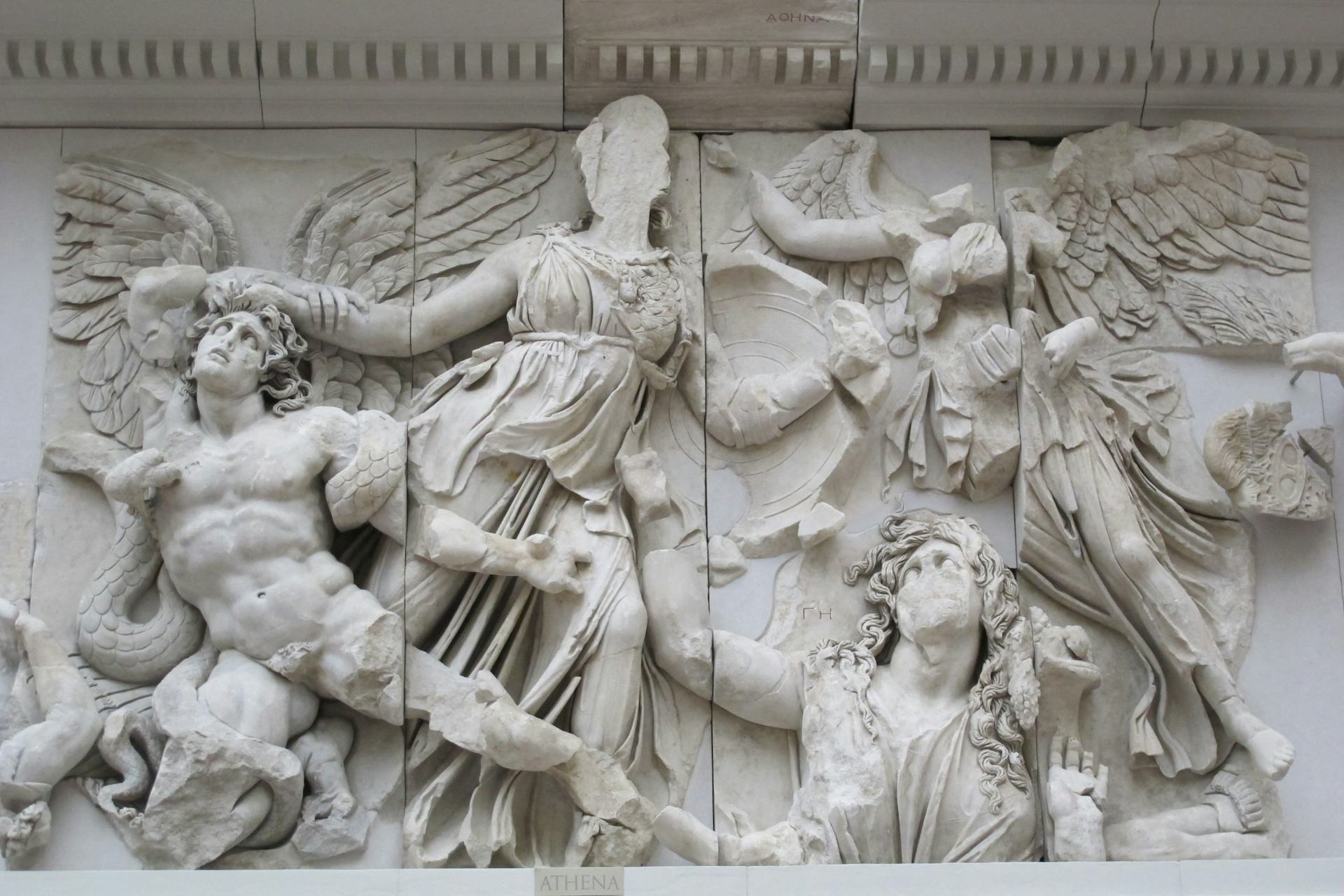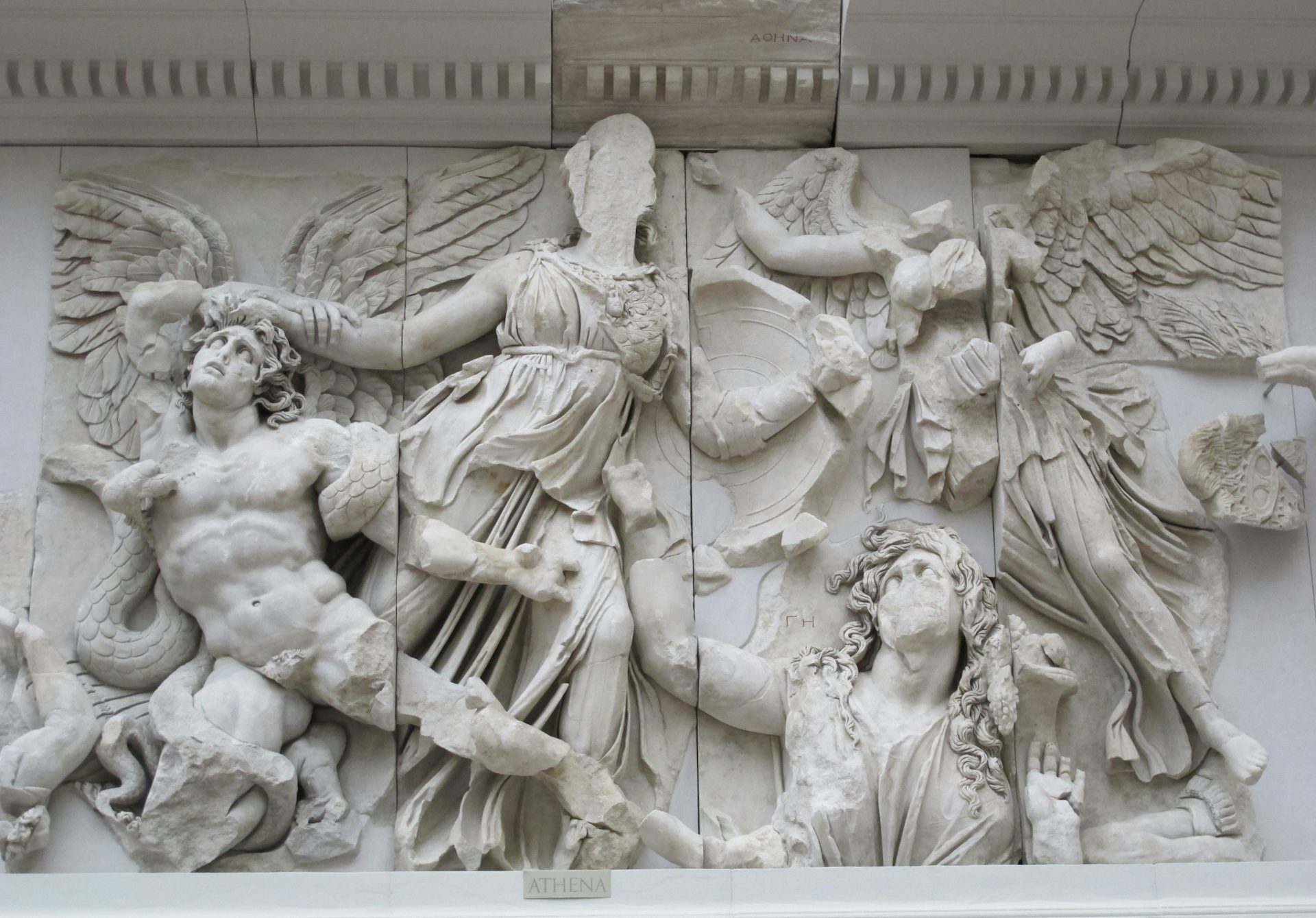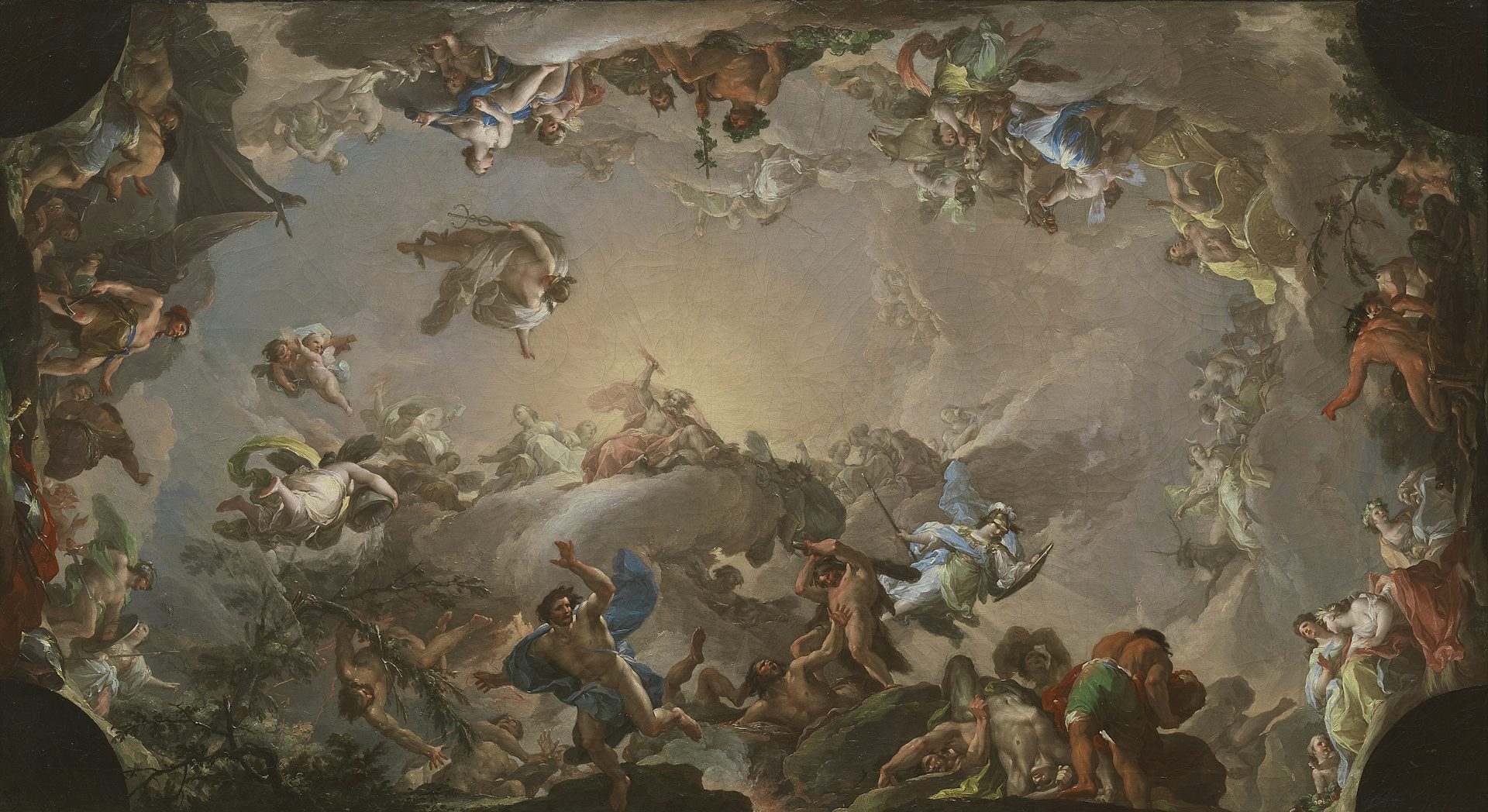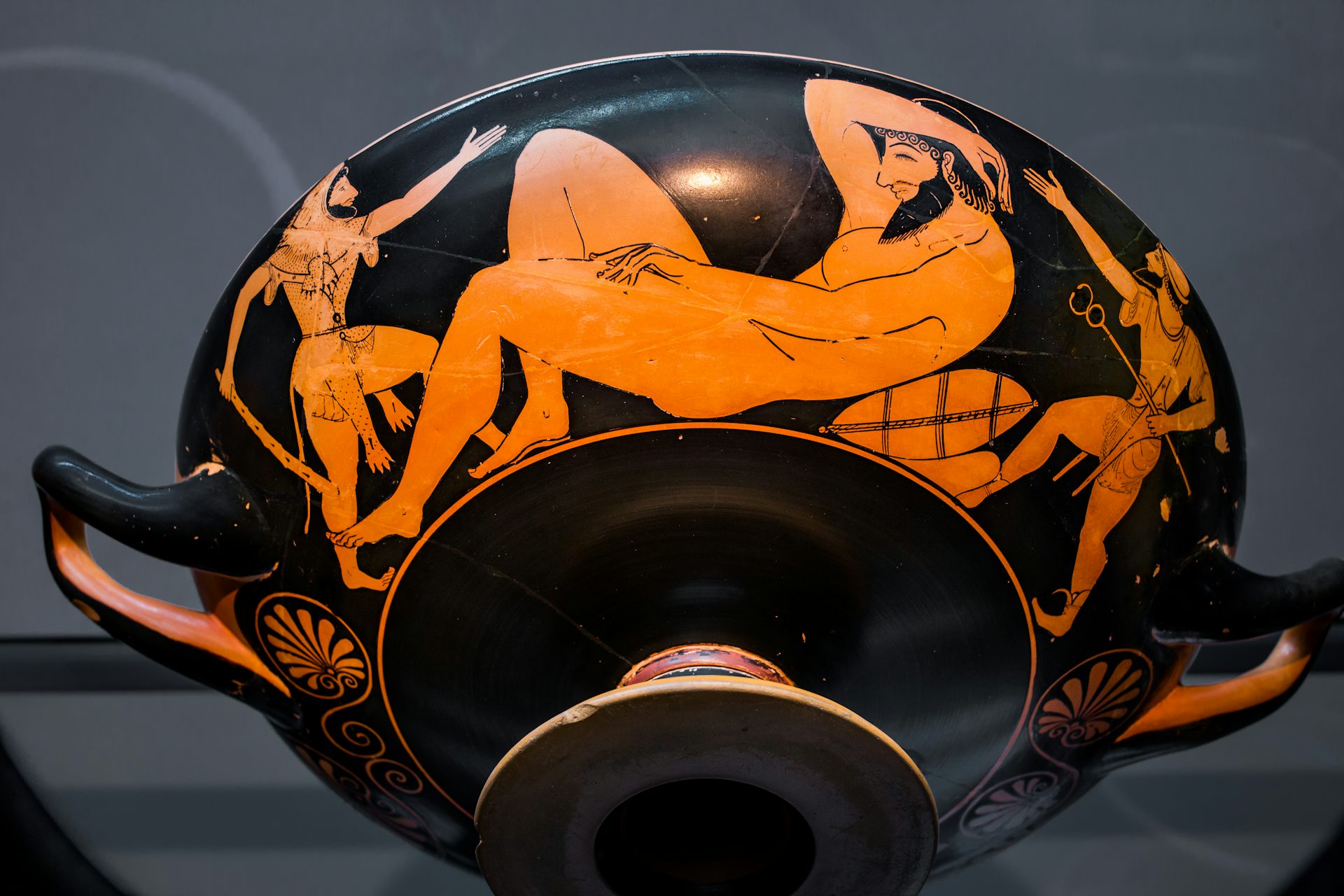Alcyoneus

Part of the frieze of the Pergamon Altar (ca. 180/160 BCE), showing Athena fighting a Giant (usually identified as Alcyoneus) during the Gigantomachy. Pergamon Museum, Berlin, Germany.
sailkoCC BY-SA 3.0Overview
Alcyoneus was one of the foremost Giants—terrible creatures born to Gaia, the primordial goddess of the earth. When the Giants set out to overthrow the Olympian gods in the war known as the “Gigantomachy,” Alcyoneus was one of the ringleaders. In some accounts, he even started the war by stealing the cattle of Helios, the Titan god of the sun.
Alcyoneus posed a unique threat, for he was immortal as long as he touched the earth of Pallene, his birthplace. He was finally defeated in battle by Heracles, who was able to kill him by dragging him out of Pallene.[1]
Etymology
The etymology of “Alcyoneus” (Greek Ἀλκυονεύς, translit. Alkyoneús) is uncertain. In antiquity, the name seems to have been connected with a bird known as the ἀλκυών (alkyṓn), or “kingfisher.” It is perhaps more likely, however, that the name is related to the Greek word ἀλκή (alkḗ), meaning “strength”—a reference to the Giants’ fearsome brawn.[2]
Alcyoneus’ name may also serve to connect him with the topography of Corinth, which contains bodies of water such as Lake Alcyon and the Alcyonic Sea. For this reason, some scholars believe that Alcyoneus and his myth originated in Corinth (see below).[3]
Pronunciation
English
Greek
Alcyoneus Ἀλκυονεύς (translit. Alkyoneús) Phonetic
IPA
[al-SAHY-uh-nyoos] /ælˈsaɪ əˌnyus/
Attributes
General
Alcyoneus was one of the Giants (or “Gigantes”), strong and violent children of Gaia best remembered for waging a war with the Olympians. In early art and literature, the Giants were usually imagined as heavily armored warriors who looked more or less like ordinary humans. But it soon became more common to represent them as monstrous creatures—human from the waist up but with serpents for feet.
Alcyoneus himself was one of the strongest of the Giants. Sometimes he was also said to be the oldest.[4] Other sources claimed that he was one of the leaders of the Giants, and that he and his brother Porphyrion led the fearsome Giant army in their war against the Olympians.[5]
According to most sources, Alcyoneus was born and lived in Pallene or Phlegrae, a city in Thrace.[6] But in other sources, perhaps representing an earlier stage of the myth, Alcyoneus was connected instead with the city of Corinth in central Greece.[7]
Alcyoneus had a handful of attributes that set him apart from the other Giants. Pindar, the earliest poet to speak of Alcyoneus, described him in one poem as a “herdsman…huge as a mountain”;[8] in another, he dubbed him a “great and terrible warrior.”[9] But the most important of Alcyoneus’ attributes was that, unlike the other Giants, he was immortal as long as he was touching the soil of his birthplace, Pallene.[10]
Other sources made Alcyoneus even more terrifying. Nonnus, for example, described Alcyoneus as nine cubits tall (roughly fourteen feet),[11] adding that he fought his enemies by using entire mountains as weapons.[12] In art, Alcyoneus was sometimes shown with serpent feet (like the other Giants), and on at least one occasion he may have even been given wings.
Some believed that Alcyoneus was buried under Mount Vesuvius after he and the other Giants were defeated in the Gigantomachy, and that the volcano’s eruptions were caused by him thrashing to get free.[13] The people of ancient Naples, meanwhile, displayed gigantic bones that were said to be those of Alcyoneus.[14]
Iconography
In ancient art, Alcyoneus was almost always shown fighting Heracles. Sometimes the two faced each other in single combat, while other times Heracles could be seen sneaking up on a sleeping Alcyoneus. Those scenes may represent a struggle that took place separately from the Gigantomachy. Occasionally the Giant was also shown with his cattle.
Artists tended to represent Alcyoneus as far more “human” in appearance than the other Giants. For instance, on the famous frieze of the Pergamon Altar (180/160 BCE), a monumental depiction of the Gigantomachy, Alcyoneus appears beardless, with ordinary human feet (as opposed to the serpent feet seen on the other Giants). He is also shown fighting with Athena rather than Heracles.[15]

Part of the frieze of the Pergamon Altar (ca. 180/160 BCE), showing Athena fighting a Giant (usually identified as Alcyoneus) during the Gigantomachy. Pergamon Museum, Berlin, Germany.
sailkoCC BY-SA 3.0Family
Family Tree
Parents
Fathers
Mother
Siblings
Brothers
Sisters
Mythology
Origins
Alcyoneus eventually came to be known as one of the most powerful of the Giants, but this was not always the case. In fact, it seems that Alcyoneus was not originally a Giant at all. Rather, he was a herdsman, warrior, and bandit connected with the city of Corinth.[20] Only later was his myth transferred east, to the region of Thrace, where he was adopted into the ranks of the Giants.[21]
The Gigantomachy
In what came to be the standard tradition, Alcyoneus was one of the leaders of the Giants, who tried to seize power from Zeus and the other Olympians during the Gigantomachy.
In some traditions, it was actually Alcyoneus who was responsible for the war between the gods and the Giants. In one version, he sowed the seeds of conflict by stealing the sacred cattle of Helios, the god of the sun, from the island of Thrinacia.[22] But another source reports that the bad blood began when Alcyoneus tried to steal the cattle of Geryon from Heracles, who had himself stolen them from the monster Geryon as his tenth labor (it is unclear how exactly this would have caused the Gigantomachy; it is possible that the source was confusing different variants).[23]

Olympus: The Fall of the Giants by Francisco Bayeu y Subías (1764).
Prado Museum, Madrid, SpainPublic DomainAfter hearing a prophecy that the Giants could only die at the hands of a mortal, the gods summoned Heracles—the strongest mortal of all—to help them. When the Giants attacked, Heracles shot Alcyoneus down with an arrow from his bow. But Alcyoneus immediately began to recover from the injury. Athena, the goddess of war and wisdom, explained to Heracles that Alcyoneus could not be killed on the soil of Pallene, where he had been born. To get around this inconvenient immortality, Heracles dragged Alcyoneus away from Pallene and was thus finally able to kill him.[24]
According to Nonnus, Alcyoneus also battled Dionysus before being slain in the Gigantomachy. Alcyoneus’ mother, Gaia, had promised her son no less a bride than Artemis herself if he defeated Dionysus (who was Gaia’s enemy). Needless to say, Alcyoneus was unable to get the better of the god of wine.[25]
Other Versions of Alcyoneus
In what was probably the earliest version of his myth, Alcyoneus does not seem to have been one of the Giants at all. Rather, he was a pastoral bandit who made the mistake of pitting himself against Heracles.
According to Pindar, Heracles encountered Alcyoneus on his way home from Troy, which he had sacked with the help of the hero Telamon and a small army. At Phlegrae in Thrace, Alcyoneus challenged Heracles to a battle. He heaved a huge boulder and knocked down twelve of the chariots that were with Heracles, killing the twenty-four warriors riding in the chariots. But Heracles was soon able to defeat Alcyoneus.[26]
In another version of Alcyoneus’ death, known from the visual arts rather than literature, Heracles killed Alcyoneus by sneaking up on him as he slept.[27]

Attic red-figure kylix by Deiniades and Phintias (ca. 520–500 BCE) that shows Heracles (left) sneaking up on the sleeping Alcyoneus (center) as Hermes (right) looks on. State Museum (Antikensammlung), Munich.
ArchaiOptixCC BY-SA 4.0Pop Culture
Alcyoneus sometimes appears together with the other Giants in modern adaptations of Greek mythology. For instance, Alcyoneus is one of the Giants (called “Gigantes”) who feature in Rick Riordan’s The Heroes of Olympus book series.